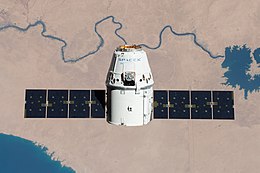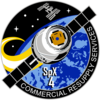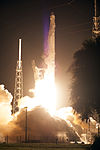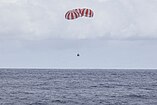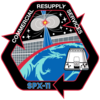
Commercial Resupply Services (CRS) are a series of flights awarded by NASA for the delivery of cargo and supplies to the International Space Station (ISS) on commercially operated spacecraft. The first CRS contracts were signed in 2008 and awarded $1.6 billion to SpaceX for twelve cargo Dragon and $1.9 billion to Orbital Sciences for eight Cygnus flights, covering deliveries to 2016. The Falcon 9 and Antares rockets were also developed under the CRS program to deliver cargo spacecraft to the ISS.

SpaceX COTS Demo Flight 1 was the first orbital spaceflight of the Dragon cargo spacecraft, and the second overall flight of the Falcon 9 rocket manufactured by SpaceX. It was also the first demonstration flight for NASA's Commercial Orbital Transportation Services (COTS) program. The primary mission objectives were to test the orbital maneuvering and reentry of the Dragon capsule. The mission also aimed to test fixes to the Falcon 9 rocket, particularly the unplanned roll of the first stage that occurred during flight 1. Liftoff occurred on 8 December 2010 at 15:43 UTC.
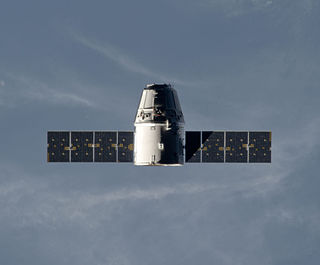
SpaceX CRS-1, also known as SpX-1, was SpaceX's first operational cargo mission to the International Space Station, under their Commercial Resupply Services (CRS-1) contract with NASA. It was the third flight for the uncrewed Dragon cargo spacecraft, and the fourth overall flight for the company's two-stage Falcon 9 launch vehicle. The launch occurred on 8 October 2012 at 00:34:07 UTC.

SpaceX CRS-3, also known as SpX-3, was a Commercial Resupply Service mission to the International Space Station (ISS), contracted to NASA, which was launched on 18 April 2014. It was the fifth flight for SpaceX's uncrewed Dragon cargo spacecraft and the third SpaceX operational mission contracted to NASA under a Commercial Resupply Services (CRS-1) contract.

SpaceX CRS-8, also known as SpX-8, was a Commercial Resupply Service mission to the International Space Station (ISS) which was launched on April 8, 2016, at 20:43 UTC. It was the 23rd flight of a Falcon 9 rocket, the tenth flight of a Dragon cargo spacecraft and the eighth operational mission contracted to SpaceX by NASA under the Commercial Resupply Services program. The capsule carried over 3,100 kilograms (6,800 lb) of cargo to the ISS including the Bigelow Expandable Activity Module (BEAM), a prototype inflatable space habitat delivered in the vehicle's trunk, which was attached to the station and, as of May 2022, is expected to remain so for five more full years of in-orbit viability tests.

SpaceX CRS-4, also known as SpX-4, was a Commercial Resupply Service mission to the International Space Station (ISS), contracted to NASA, which was launched on 21 September 2014 and arrived at the space station on 23 September 2014. It was the sixth flight for SpaceX's uncrewed Dragon cargo spacecraft, and the fourth SpaceX operational mission contracted to NASA under a Commercial Resupply Services contract. The mission brought equipment and supplies to the space station, including the first 3D printer to be tested in space, a device to measure wind speed on Earth, and small satellites to be launched from the station. It also brought 20 mice for long-term research aboard the ISS.

Dragon 2 is a class of partially reusable spacecraft developed and manufactured by American aerospace manufacturer SpaceX, primarily for flights to the International Space Station (ISS). SpaceX also launches private missions, such as Inspiration4 and Axiom Space Missions. There are two variants of the Dragon spacecraft: Crew Dragon, a spacecraft capable of ferrying four crewmembers, and Cargo Dragon, a replacement for the original Dragon 1 used to carry freight to and from space. The spacecraft consists of a reusable space capsule and an expendable trunk module. The spacecraft launches atop a Falcon 9 Block 5 rocket and the capsule returns to Earth through splashdown.

SpaceX CRS-10, also known as SpX-10, was a Dragon Commercial Resupply Service mission to the International Space Station (ISS) which launched on 19 February 2017. The mission was contracted by NASA as part of its Commercial Resupply Services program and was launched by SpaceX aboard the 30th flight of the Falcon 9 rocket. The mission ended on 19 March 2017 when the Dragon spacecraft left the ISS and safely returned to Earth.

SpaceX CRS-11, also known as SpX-11, was a Commercial Resupply Service mission to the International Space Station, launched successfully on 3 June 2017. The mission was contracted by NASA and was flown by SpaceX. The mission utilized a Falcon 9 launch vehicle and was the first reuse of C106, a CRS Dragon cargo vessel that was previously flown on the CRS-4 mission.

SpaceX CRS-12, also known as SpX-12, was a Commercial Resupply Services mission to the International Space Station launched on 14 August 2017. The mission was contracted by NASA and was flown by SpaceX using a new Dragon capsule. The Falcon 9 rocket's reusable first stage performed a controlled landing on Landing Zone 1 (LZ1) at Cape Canaveral Air Force Station. After delivering more than 2,900 kilograms (6,400 lb) of cargo, the Dragon spacecraft returned to Earth on 17 September 2017.

SpaceX CRS-13, also known as SpX-13, was a Commercial Resupply Service mission to the International Space Station launched on 15 December 2017. The mission was contracted by NASA and is flown by SpaceX. It was the second mission to successfully reuse a Dragon capsule, previously flown on CRS-6. The first stage of the Falcon 9 Full Thrust rocket was the previously flown, "flight-proven" core from CRS-11. The first stage returned to land at Cape Canaveral's Landing Zone 1 after separation of the first and second stage.

SpaceX CRS-14, also known as SpX-14, was a Commercial Resupply Service mission to the International Space Station launched on 2 April 2018. The mission was contracted by NASA and was flown by SpaceX. This mission reused the Falcon 9 first stage booster previously flown on CRS-12 and the Dragon capsule flown on CRS-8.

SpaceX CRS-15, also known as SpX-15, was a Commercial Resupply Service mission to the International Space Station launched 29 June 2018 aboard a Falcon 9 rocket. The mission was contracted by NASA and flown by SpaceX.

Dragon, also known as Dragon 1 or Cargo Dragon, was a class of fourteen partially reusable cargo spacecraft developed by SpaceX, an American private space transportation company. The spacecraft flew 23 missions between 2010 and 2020. Dragon was launched into orbit by the company's Falcon 9 launch vehicle to resupply the International Space Station (ISS).

SpaceX Dragon C108 is a Cargo Dragon space capsule built by SpaceX. It is the first Dragon capsule to be flown three times, having its third launch in 2019. C108 was first used on CRS-6, and then used again for the CRS-13 and CRS-18 missions. It was the first capsule to be used a third flight, marking a milestone in SpaceX's drive to reduce space launch costs through reusing hardware.

SpaceX CRS-21, also known as SpX-21, was a Commercial Resupply Service mission to the International Space Station which launched on 6 December 2020. The mission was contracted by NASA and was flown by SpaceX using a Cargo Dragon 2. This was the first flight for SpaceX under NASA's CRS Phase 2 contract awarded in January 2016. This was also the first Cargo Dragon of the new Dragon 2 variant, as well as the first Cargo Dragon flight that was docked at the same time as a Crew Dragon spacecraft. This mission used Booster B1058.4, becoming the first NASA mission to reuse a booster previously used on a non-NASA mission. This was also first time SpaceX launched a NASA payload on a booster with more than one previous flight.
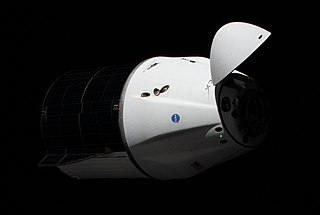
SpaceX CRS-22, also known as SpX-22, was a Commercial Resupply Services (CRS) mission to the International Space Station (ISS) that launched at 17:29:15 UTC on 3 June 2021. The mission is contracted by NASA and is flown by SpaceX using a Cargo Dragon 2. This is the second flight for SpaceX under NASA's CRS Phase 2 contract awarded in January 2016.

Dragon C209 is the second Cargo Dragon 2 spacecraft, and the second in a line of International Space Station resupply craft which replaced the Dragon capsule, manufactured by SpaceX. The missions are contracted by NASA under the Commercial Resupply Services (CRS) program. It was being flown for the first time on the CRS-22 mission on 3 June 2021. This was the second flight for SpaceX under NASA's CRS Phase 2 contract awarded in January 2016. This was also the second time a Cargo Dragon was docked at the same time as a Crew Dragon spacecraft, SpaceX Crew-2. This mission used a new Booster B1067.1.
